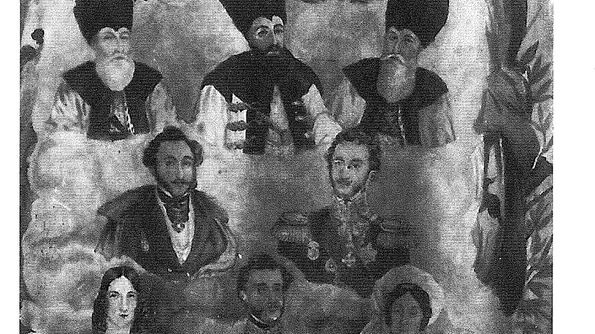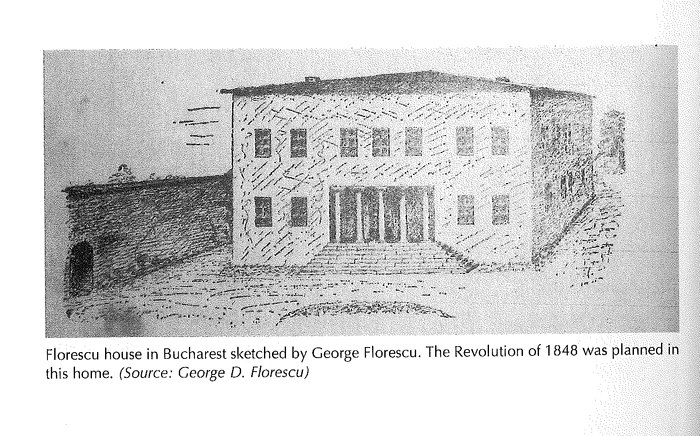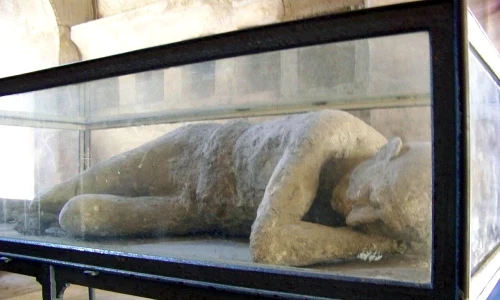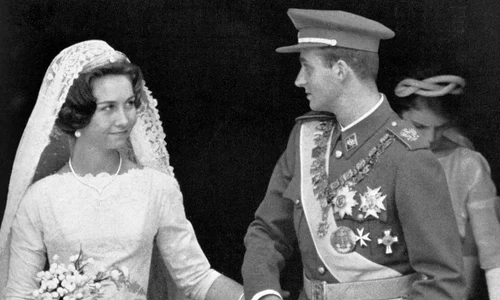
Liberals, Romantics, Revolutionaries - The Florescus and the 1848 revolution
The events of 1821, when the Greek uprising of Ypsilanti and his Philike Hetairiasociety clashed with the homegrown Romanian revolutionary forces of Vladimir Tudorescu, marked not just the political end of the Phanariot regime in Romania, but also the end of a Greek Romanian cultural experiment, which I have characterized as neo-Byzantine in my previous article.
Alexandru Ypsilianti, the son of a Phanariot Prince, had called for the liberation of all Orthodox Christians living under Turkish rule, initially with encouragement of the Russian Tsar Alexander I. But he had paid scant attention to nascent Romanian national feeling, barely acknowledging its existence, and when his movement clashed with Tudor Vladimirescu’s forces, it ended in disaster, with Vladmirescu calling for a popular uprising against Phanariot rule and the exploitation of the peasantry by Greek ciocoi (upstart landlords), even asking the Ottomans to help achieve that aim. Eventually, Ypsilianti ended up complicit in the murder of Vladimirescu, and, without much support in Romania but also having lost Russian support, he ended up fleeing abroad, eventually organizing a new, ultimately successful, uprising on Greek soil. After the tragic events of 1821, it was possible to feel Greek and it was very possible to feel Romanian, but it was practically impossible to feel Greek Romanian, like so many members of the Phanariot regime had felt.
At the time of the 1821 revolution, Iordache Florescu, who had sat on the Princely divan in the early nineteenth century, was married to Anica Sutu, the sister of the last Phanariot Prince to rule Romania.

Accordingly, he was closely associated with the Phanariot regime. Fearing repercussions from Russia and Turkey, his reaction was to flee across the border to Transylvania, like so many of his Florescu predecessors, putting himself and his family under the protection of the Hapsburg Empire. He was joined by some one hundred other Moldovan and Wallachian boyars, equally fearful for their lives. Once there, he settled down in Brasov with his wife, his four children (six more were to come), his brothers Emanoil and Alexandru, and his mother Anica Ghica, and was given leave to live in the fortified city centre, whilst most of the other emigres were based in the Romanian Scheidistrict of the city outside the town walls, where they had their own school. In Brasov, Iordache became the de factoleader of the Romanian émigrécommunity. As such he had to settle a number of disputes between the Romanian newcomers and the more sombre residents of a town which was predominantly German at the time.
It was only after the Turks, to whom Vladimirescu had wisely appealed, decided to acquiesce to certain of his demands for removing Greek influence, under the principal of divide et impera, that the situation was pacified, and it made sense for Iordache, his family, and countless other Moldovan and Wallachian boyars, to return to their homes across the Transylvanian border. But the situation in Bucharest was changing rapidly, not least because of growing Russian influence. Ever since 1779, the Porte had recognized Russia’s “right of intercession” in the two Romanian principalities, and in 1802, a convention between Russia and the Porte had established a Russian veto on the deposition of a ruling Prince, who now had to be named for a fixed term of seven years. By the treaty of Ackerman of 1826, Russian rights of interference were further strengthened, with Russian consuls in Bucharest and Iasi having the right to be “consulted” on all important decisions. Finally in 1829, after Russia re-occupied the two territories, they were transformed into de factoRussian protectorates, with the local Princes to be elected for life (i.e. without Ottoman interference) and no Ottoman military presence allowed on the left bank of the Danube. Crucially, the Peace of Adrianople also abolished all sorts of Ottoman restrictions on commerce in the principalities, opening up the grain trade, and thereby inaugurating a period of sustained economic development. It was also after that Treaty that the Principalities were to experience the enlightened government of the Russian General Pavel Kisseleff, who was responsible for introducing the first semblance of a constitution (although narrowly oligarchic) in theReglement Organique, promulgated in 1831 in Wallachia and in 1832 in Moldavia.

The continual wars between Russia and Turkey on Romanian territory acted as a terrible drain on the principalities, but the growing Russian presence (which mirrored diminishing Turkish influence) also led to profound changes in the ways people lived. The journals of foreign travelers to Moldavia and Wallachia in the early nineteenth century are full of references to boyars whose families had worn oriental (Turkish) costumes for generations suddenly shaving off their beards, getting rid of their oriental headgear, and adopting western clothes. The “westernization” of Romanian society started earlier in Iasi, the more sophisticated of the two capitals and the one closest to Russia, but soon spread to Bucharest. It was noticed that the ladies of the boyar class were the first to adopt western habits (including the very fashionable western habit of taking lovers!), but the men were not far behind. And the change did not involve just the way people dressed, but more generally how they lived, and very soon merchants were busy bringing not only the latest Paris fashions in clothes (via Vienna and Leipzig) to the two capitals, but also in furniture and carriages, whilst the houses of boyars were beginning to fill up with western governesses looking after the children, whilst dance instructors were brought in to teach the joys of the valse, the mazurka and the polonaise.

Nicolae Balcescu
Although the above changes may appear, and in some respects were, superficial and to a certain extent opportunistic, they also reflect deeper currents of western thought which were gradually penetrating Romanian lands. We have seen in the previous article how the gradual penetration of Greek culture in Romanian lands had made the Romanian elites more sophisticated, urbane and cosmopolitan, while certain Phanariots had brought with them the first seeds of enlightened thought. Paradoxically, it was these very influences which made the Romanian boyars so prone to abandon their Greek, i.e. oriental or Turkish, habits and adopt a more western lifestyle. Indeed, one could add that the very Turkish clothes worn by previous generations had themselves been equally superficial in the sense that they did not truly reflect the hybrid cultures of the people who wore them. A good illustration of this is an anecdote recorded by the French traveler Langeron in the late eighteenth century, who describes his surprise when a very oriental-looking boyar addressed him in perfect French, seemed perfectly up to date with the latest developments in French culture, and was very familiar with Paris, a city he had never visited!. This episode goes some way towards explaining how fertile the two principalities were for a widespread adoption of French customs by the elites. For it was specifically French models of culture and behavior which the Russian officers brought with them when they mingled with the Romanian elites. In this respect, not for the first time in Romanian history, a foreign cultural model was imported, not directly from its originator (in this case France), but from a third party (in this case Russia), whose elites had adopted French models about a century beforehand (just like in the fifteenth century, Byzantine models had been adopted not directly, but via the kingdoms of Bulgaria and Serbia).

Iordache would have been one of the first boyars to adopt “western” clothes, and it is within the context of growing Russian influence that we should see his decision to marry of his daughter Luxita at the tender age of sixteen to Filip Krijanowski, one of the Russian officers serving under General Pavel Kisseleff. The couple were given a separate flat to live in in the Florescu household, but within three months the marriage ended in disaster, apparently due to Krijanowski’s brutal mistreatment of his wife. Although we do not know the full details, it seems that Luxita became physically ill, and the Florescu family eventually had to call on the Metropolitan Neofit to help find a solution, and he duly dispatched a clergyman to provide medical and spiritual aid. Finally, General Kisseleff, the head of the Russian occupying forces, who had attended the wedding, had to come over to help solve the problem, and, being a fair-minded person, he ordered that Krisanowski be transferred out of Bucharest. He eventually re-joined his regiment in disgrace, and in 1836, after three years, Luxita finally obtained a divorce settlement, including a monthly payment of 1, 500 ducats and 200 lei. The incident left Luxita morally shattered, and she was marked for the rest of her life.
It was around this time that the first generation of Romanians was returning to Bucharest, having completed their studies in France. A trickle at the turn of the nineteenth century, soon not only members of the leading families were being educated there, but also a number of lesser boyars obtained sponsorships for their studies abroad, and some were to play a leading role in the revolutionary events to come. These students, who were typically sent to study at the Sorbonne or the College de France, became enamored of French literature, the theatre, its culture and lifestyle, whilst leading a pleasant existence in the French capital. But to varying degrees they also became exposed to increasingly liberal ideas, and some of them got absorbed by the revolutionary and socialist forces which were beginning to take issue with the restoration regime of Louis Philippe. The early nineteenth century timing of this new trend was crucial, for it allowed the young members Romanian boyars to be inspired by the ideals of the French Revolution, without having had to experience the massacres and bloodshed which followed the Revolution itself, as so many intellectuals had done beforehand, turning them into lifetime conservatives.
Some of the young Romanian revolutionaries joined the socialist clubs of Fourier and Louis Blanc, while others joined the revolutionary salon of Misckievicz. Eventually, the Romanian emigres in Paris, not only were inspired by the ideals of liberty, equality and fraternity of the French Revolution, but also realized that they themselves shared a Latin past with their French “cousins”. Accordingly, ideas of revolution and social justice began to mix in with ideas of national liberation, pride in Romanians’ Latin past, and a call for the unity of all Romanians living in Moldavia, Wallachia and Transylvania. More specifically, these idealist students dreamt of liberating Romania both from Russian and Turkish influence, of ending the narrowly oligarchic regime of the Reglement Organiquewhich had replaced the Phanariot system, and of a united and independent Romania, with greater rights for the peasantry. They soon created their own secret society, which was called Fratia si Dreptate.

Upon their return to Romania, these secret revolutionaries, which included the Golescu brothers, Ion Heliade-Radulescu, Balcescu and the Bratianu brothers started to meet secretly in the basement of the Florescu household, encouraged by Luxita and her young brothers Dumitru and Costache, all of whom were actively involved in plotting the revolution, whilst the other members of the family remained passive supporters. A description of this now demolished household, which had extensive gardens and orchards along the banks of the Dambovita River, as well as a church and out-buildings for staff and the household’s gypsy slaves, has survived in a 1826 document:
‘’Along it, from the eastern side, it goes from the street leading to the bridge down to the Dambovita River and from the Dambovita it continues up to the back lane and along the wall of the Metropolitan’s (Bishop’s) guest house, which had been the school, up to the barber shop that is next to the Old Saint Spiridon Inn, it continues on both sides, as the wall built by our ancestors shows. Its neighbors are on the one hand the Metropolitan’s guest house and on the other the Old Saint Spiridon Inn.”
The house had been acquired by Iordache on his return from Brasov from an impoverished distant relative. It had originally been part of the dowry of Ancuta Cantacuzino when she had married Stroe Florescu in the late 17thcentury.
It is in this house that one of the leading revolutionaries caught Luxita’s eye. If Garibaldi had been a historian of note, a diplomat and a pragmatist as well as a revolutionary and unifier of Italy, he would have shared all the great qualities of Nicolae Balcescu. From a minor boyar family, and not wealthy enough to study abroad, he had attended the famous Saint Sava Academy of Bucharest, where young Romanians were increasingly exposed to a western education, and put in touch with their Latin past. After his studies, he enrolled in the army where he rapidly became a talented officer, but in 1840 he got involved in a republican revolutionary plot led by his friend Dimitire Filipescu, and was duly imprisoned, including three years of confinement at Marghineni, where he contracted tuberculosis. A fine portrait of Balcescu by the “revolutionary painter” Ion Negulici reveals a handsome man, with a strong determined look, but also kind and sensitive features. His ideas had a lot in common with the later revolutionary idealism of Garibaldi and Mazzini, and he could not conceive that his universal ideas of liberty and friendship amongst peoples could one day result in enmity between different ethnicities or nationalities.
It was shortly after his liberation that he started frequenting the Florescu household and met Luxita. Balcescu and Luxita were to experience a profound and passionate love affair, where their mutual love mingled with their shared ideals of national liberation and aspirations for a fairer society. They kept their affair secret (except that all their movements were followed by Russian and Austrian secret agents!) and eventually travelled separately to a Spa in Transylvania, from where they started an odyssey across Europe, where Nicolae Balcescu was constantly in touch with other revolutionaries, and where he consulted various libraries and archives for his historical interests. They arrived in Vienna where they met other revolutionaries such as Costache Negri, and then on to Italy, where they stayed in Venice, Florence, Pisa, Rome, Naples and eventually Palermo. Throughout these travels, Luxita’s father Iordache continued to provide his daughter with money and also helped to arrange various visas for her, probably having felt much remorse at his decision to marry her off to a brutish Russian officer at such a young age.
Eventually, the couple travelled separately to Paris. But when Balcescu arrived, he was distraught when he found out that Luxita had already left. She had started to travel back to Bucharest, accompanied by her younger brother Costache, because she did not want him to know that she was pregnant. Balcescu wrote her a passionate letter, which has survived:“Paris is empty without you…you are the only woman I love…I will not return to Romania unless I have the certitude of seeing you”, ending the letter “I need you desperately”.
Luxita eventually reached Bucharest in October 1847, where she attended the funeral of her father Iordache, but when Balcescu caught up with her, she had already left the capital, again not wanting to inform him about her pregnancy. The 1848 revolution in Romania eventually broke out in May, with Balcescu playing a key role, becoming a member of the revolutionary government headed by the compromise candidate Metropolitan Neofit (the very man who had had to deal with Luxita’s disastrous wedding to Krinawoski). The main aims of the Romania’s 1848 revolution, which included abolishing class privileges, democratizing society, unification with Moldova, land reform and emancipation of the peasants, gypsies and Jews, were very much typical of mid-century European liberalism, and show how much the Principalities had changed since the end of the Phanariot regime a quarter of a century beforehand. Balcescu was not the most radical of the revolutionaries, and his main priorities were the national unity of all Romanian lands and the social emancipation of the peasants, as well as getting Turkey to recognize the new regime. Luxita’s brothers Costache and Dumitru were too young to play a leading role in the revolution, but still managed to play an active role, with Costache participating in the burning of the Russian constitution, and at one crucial point, after the arrest of three of the revolutionary leaders, jumping from the Prince’s palace to create a diversion, and appealing to the people to follow him and free the three revolutionary leaders. Meanwhile, the Florescu family were so excited by the events of the revolution that they immediately freed the gypsy slaves working in their household “because we have repeatedly opted for liberty”, as they explained in a document of the time signed by Dumitru Florescu amongst others. Nicolae Golescu then thanked the Florescu family for this symbolic act on behalf of the revolutionary government.
The revolution was temporarily a success, but was eventually crushed by overwhelming Russian and Turkish force, with the revolutionary leaders fleeing into exile, including Costache who, disguised as a Franciscan monk, managed to get out of Bucharest. Meanwhile, his sister Luxita escaped to Budapest, which was itself going through a revolution under Kossuth. It was in Budapest amongst this revolutionary fervor that her son from Balcescu was born on the 14thMay 1848. He was baptized a few days later on the feast day of St Boniface in Budapest’s Romanian Orthodox church, and duly named Boniface. But Luxita declared him illegitimate and, in perilous physical and moral condition, she seriously considered putting him up for adoption. Later on she admitted being near death at the time, and was also desperately short of money. She was also very keen to hide her pregnancy from her mother.
Balcescu also escaped and started a new tour of Europe where he was in touch with revolutionaries across a number of countries, including a visit to Hungary where he tried to persuade Kossuth to grant ethnic Romanians equal rights in Transylviania, and a visit to England in 1850, where he tried to gain support for an independent Romanian state. But Luxita was never going to see him again, and her last letters to him are full of references to her “suffering”, and her esteem and admiration for Balcescu’s patriotism. She also expressed anger at the Metropolitan Neofit’s betrayal of the revolution. Eventually, in 1851 when Balcescu eventually found out that he had a son, he was already near his tragic and premature death at the age of thirty-three, having returned to Palermo after having visited the South of France, in the constant search of a warmer climate to alleviate his tuberculosis. His last letter to Luxita asks for forgiveness for all the suffering she endured due to his troubled and turbulent life, while her last letter to him must have provided him some relief as he lay on his deathbed:
“I have found out that your are in Sicily, in Palermo, where you will spend the winter, but I don’t know if you have any friends with you, someone to be with you, and the idea that you may be alone hurts me bitterly;how happy would I be, my dear friend, if I could take on your sufferings, just to see you relieved of them. Myself, Bonfiacio and all our own are healthy, and they send you their regards. Bonfiaciu kisses your hand and I, my friend, kiss your hand a thousand times, and want you to know that I am, as I always have been, your good friend”
He was to die on the 29thNovember 1852 at Palermo’s “Alla Trinacria” Hotel, and was buried in a common grave, without friends or money to pay for a proper burial ceremony.
The demise of the 1848 revolution was a disaster for the Florescu family, as it was for the other revolutionaries, most of whom fled into exile. Costache and Dumitru initially travelled on an Austrian ship to Constantinople, and then moved on to Bursa in May 1849. Dumitru stayed on in Turkey, taking care of the Romanian community there, whilst his brother Costache was allowed to leave for Paris on condition that he would not return to Romania, and ended up studying law at the Sorbonne. But he made the mistake of eventually returning to Romania, and was arrested on the orders of the Russian ambassador to Constantinople. He ended up spending two years in a harsh Tsarist subterranean jail in Kiev, and then was sent on to a camp in Nijni Novgorod, from which he escaped, eventually reaching Siberia. Astonishingly, he managed to make his way back to Bucharest on foot, arriving at this family house in 1856, very much a broken man. Because of the freezing temperatures he had had to endure, he had lost the use of his feet, and was never able to walk properly again. Of the Florescu household, only his mother recognized him. He devoted the rest of his life to writing memoires of his experiences, eventually dying in 1875.

Tiganesti Monastery
Dumitru had a luckier escape. As a young man, he had spent time at the Florescu’s ancestral home in Cornateni in the sub-Carpathian mountains, which had been inherited from Vintila Florescu in the 1500’s. He had been enchanted by the simple melodies of the local peasants, and often joined them in their horadances. He became passionate about music, and took piano and singing lessons in Bucharest under Ludovic Wiest, a well-respected German teacher. One of Dumitru’s formative experiences was hearing Liszt perform a number of concerts in Bucharest during a visit in 1846. Dumitru, then aged 18, was spellbound by this charismatic romantic, in particular when Liszt played a number of improvisations based on Romanian folk songs. After the failure of the 1848 revolution, Dumitru spent some time in Turkey, where he organized a Romanian revolutionary cell with the help of Ioan Ghica, another revolutionary. But he eventually got passage on a ship to Marseille, and made his way to Paris. He had with him a letter from the elder Golescu to his younger brothers in Paris asking them to treat Dumitru as if he was one of their own brothers. He then began studying law and letters at Paris’ Sorbonne University, where he rented a small apartment in the Latin quarter of the city. But his real passion remained music, in particular German music, and his goal remained that of becoming a professional musician. At the time, this was considered an unacceptable profession for a Romanian of his background, so he kept this a secret from his family, whom he depended on for money.
However, he eventually enrolled in the Paris conservatory, where he was lucky to be taught by some of the great teachers of the time, including Halevy, Coupey, Auber and Terrot, and he took singing lessons at the famous school founded by Emile-Joseph-Maurice-Cheve, based on the method of Pierre Galin. Throughout this period, he continued to receive small subsidies from his mother, which allowed him to live a modest existence in the less salubrious quarters of the city. Finally, Dumitru achieved his dream of becoming a composer, and he always saw music as a profound link to his Romanian fatherland and the peasant life he had witnessed in his childhood. His most famous composition is Steluta (“Little Star”, which can be heard on Youtube!), a lyrical song based on a poem by Vasile Alecsandri, a close family friend, but he also wrote many other compositions, usually inspired by Romanian romantic poetry. A late composition was the “Hora lui Cuza”, a sort of national anthem written in 1859 on the occasion of Prince Cuza’s triumphant entry into the city of Bucharest in 1859.
In 1853, Dumitru was allowed to return to Romania by the Stirbey government, and he arrived in 1854. Upon his return, Prince Sturdza asked him to come up with a proposal for founding a Romanian musical academy, but the project was derailed by the Crimean War. Apart from music, he pursued a career in politics, becoming the Mayor of Tjrgoviste and Prefect of the surrounding Dimbovita area where the old Florescu family estates had been located. He was elected to the Senate in 1875, and eventually became its President. But he never gave up his interest in music, and he finally became a Professor of violin and cello at the very Bucharest conservatory which he had previously been asked to set up. His last years were spent organizing musical soireesfor Carmen Sylva, the eccentric wife of King Carol I, at the new Royal Palace in Sinaia and at the Cotroceni Palace in Bucharest, at which he himself often played. But his life was cut short at the age of 48 by a sudden heart attack in 1875, leaving his wife Alexandrina Mihailescu six children to take care of.
By the time Costache had returned to Bucharest in 1856, Luxita was not there to greet him for she had moved to Paris with her son Bonifaciu, whom she had officially adopted at the age of ten. He received a French education at the prestigious Lycee Louis le Grand, followed by a degree in liberal arts, and a BA from the Sorbonne in 1872. Bonifaciu developed a strong passion for French literature, and once his studies ended he returned to Bucharest where he became an eminent Professor of French language and literature. He published many books on these subjects, and was a well-loved Professor at Iasi University and then a teacher at the famous Saint Sava school of Bucharest.
Luxita herself became the director of a Catholic charitable institute in Bucharest, and continued to lead a modest life on the meagre salary she drew. Her good management of that institution was acknowledged by the Austrian Emperor Franz Joseph, who awarded her a beautiful jewel in recognition for her activities, which she proudly wore until her death in 1898.
Luxita always made sure that Bonifaciu was fully aware of the great man his father had been, and she taught him to live up to Balcescu’s ideals. Throughout his life, he remained an ardent Francophile as well as a Romanian patriot. Luxita also ensured that Bonifaciu was fully recognized by the Florescu family, and he was given the Florescu surname. But he remained closer to the memory of his father Balcescu than to his Florescu roots, and he never abandoned his liberal and anti-aristocratic outlook. Indeed, referring to his Florescu heritage, he is known to have said:“I don’t care whether I am a descendant of Michael the Brave or Nicholas the Gypsy, so long as I am a virtuous man”, and on another occasion he may have scandalized some members of his Florescu family when he commented “Let us congratulate ourselves that there are no more boyars.” He was buried in the monastery of Tiganesti just north of Bucharest, which had been built by his grandfather Iordache, and which became the resting place for most of the nineteenth century family members.
The Romanian revolution of 1848 may have ended in disaster, but its very existence is a reminder of how much Wallachia and Moldavia had changed since the early nineteenth century, when they still formed an obscure corner of Europe under Turkish rule. Furthermore, in 1859, within just over a decade of the revolution’s brutal repression, all the most cherished dreams of the revolutionaries had been accomplished, including the unification of Wallachia and Moldavia and national independence, with land reform and emancipation of the peasantry to follow shortly thereafter.
Whilst Marxist historians have tended to see the European revolutions of 1848 as essentially the expressions of the emergence of a new bourgeois class, this was definitely not the case in Romania, where the leadership of the revolution was drawn almost exclusively from aristocratic ranks, although its leaders did manage to get the broader support of a number of merchants and tradesmen. Indeed, the 1848 revolution in Romania did not divide classes against one another. Rather, it divided up entire families, with many shades of liberalism visible within the same families, and in some cases, such as the Ghicas and Golescus, some family members repressing a revolution to which other family members had Cumpără acummade an enormous contribution. In many ways the Romanian revolution of 1848 is a powerful reminder that often it is not class and economics that drives history onwards, but rather the power of ideas, in this case the ideas of national unity, liberty and fraternity which some young Romanians had learnt to love so much.















